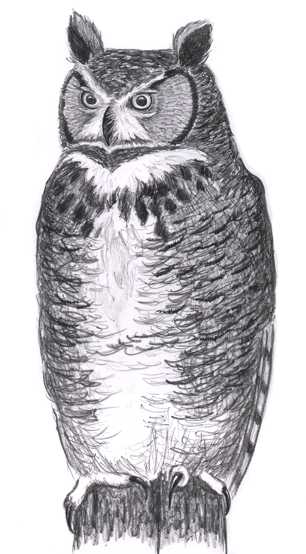
Dear Bird Folks:
For the past week or so I have been hearing Great Horned Owls calling near my house. I’ve read that owls are early nesters and start hooting as early as January. But it’s fall now. Isn’t that a bit early for them to be setting up a breeding territory?
-Steve, Orleans
Yes Steve,
It is way, way too early for breeding. No bird wants to be dealing with newborns this time of year. Even for the potential tax deductions, it is not worth having offspring this time of year. I used to think that early winter was the best time to hear Great Horned Owls also. (You and I must have read the same book.) Then I started paying attention to the time of year that I heard owls and came to the conclusion that Great Horned Owls never shut up. Never. It seems that I can go out on any given night and hear an owl hooting somewhere in my neighborhood. These guys like to talk.
Most birds have a breeding territory in the spring. They sing their brains out for weeks at a time. But once the kid deal is over, they pipe-down and forget about the whole thing until next year. A few birds even have a feeding territory. They breed in one area, then move away to another area for the winter and defend it.
Great horns on the other hand, just like those losers you went to high school with, spend most of their lives in the same town. They eat, breed and sleep, year after year on the same territory. There is no long winter’s journey south for Great Horned Owls. Except for a few weeks at the end of the summer, to get away from their nagging kids or if food becomes short, most great horns live and die fairly close to where they were born.
This home territory thing is very important to these owls. An owl pair may defend the same piece of real estate for years. That is why, Steve, you are hearing so much hooting, even in the fall. After the summer ends and the young birds move out, the adults may wander a bit, but soon return to their territory and reestablish their bond by calling back and forth. With all the young hotshot punk owls looking to move in on their turf, it is important that older owls remain close by to make it known who’s in charge.
A Great Horned Owl territory is not to be taken lightly, they are one of the baddest birds on the planet. They have practically no natural enemies, now that the dinosaurs have become extinct. They will hunt, kill and eat mostly anything. The lengthy list of prey includes woodchucks, fish, snakes, herons, geese, cats, skunks, porcupines, hawks and in South America, monkeys. That’s right, they eat honest to goodness monkeys. I’ve even heard of owls plucking passengers out of slow moving convertibles on a hot summer’s night. (See, there’s another reason to wear your seat belt.)
If you ever find an active owl’s nest, look around on the ground below. You’ll be shocked at what you will see. I remember finding a nest a few years back. There were feet, skulls, claws and beaks everywhere. The entire area looked like a circus train had exploded. Owls not only eat just about everything, but they also kill much more than they need. Uneaten bodies of assorted creatures can often be found stacked up on the nest for the young owls to eat. Now before you start thinking all this is gross and owls are somehow evil, open up your freezer. I’m sure you’ll find your own collection of dead things that would rather not be there.
Hearing owls calling on a crisp autumn evening is one of the true wild sounds of nature. You are lucky to hear them Steve. There is something haunting about these powerful mysterious birds. But don’t worry, they won’t bother you, unless you have a convertible and forget to wear your seat belt.